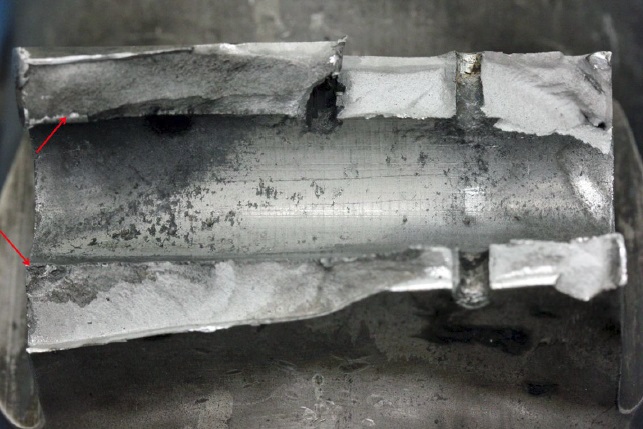Metro 23 MLG Corrosion Causes Runway Excursion
On 20 February 2014 Fairchild SA227-DC Metro 23 (Metro IV) VH-UUB, was being operated on a charter flight from Avalon to Portland, Victoria by Sharp Airlines. Shortly after touch-down the aircraft veered off the runway at 75-80 knots. The 10 passengers and two crew were all uninjured.
The Safety Investigation
The Australian Transport Safety Bureau (ATSB) report that:
The runway excursion resulted from failure of the lower torque link attachment lug on the left main landing gear’s yoke.
This allowed the wheels to rotate through 90° with respect to the direction of aircraft travel and skid, producing a large braking effect on the left side.
Sharp Airlines SA227-DC Metro 23 VH-UUB after Veering Off Runway: Note the Newspaper Hiding the Aircraft’s Modesty! (Credit: Sharp Airlines via ATSB)
The Fracture
The failure…resulted from pre-existing cracks that had progressively grown until the part had insufficient strength to support normal landing loads. The cracks initiated principally from areas of pitting corrosion in the lug’s bore and were propagated by cyclic stresses imposed during operation.
The fractured [7075-T73 aluminium] yoke [manufactured by Klune Industries] contained four disused retaining pin holes (two each top and bottom) as a result of compliance with a service bulletin (SB) for installing a replacement [torque link shaft]TLS (CC7-32-012), released in 2002. The SB required drilling of a new pin hole in the lug to secure the replacement TLS and filling of the redundant holes with sealant.
Sealing of the disused pin holes in this occurrence was not adequate as the sealant had either broken down over time or otherwise disbonded and come loose during service, providing additional entrance routes for moisture or other corrosives. Another entrance route was associated with wear on the yoke lug flanks where significant pitting was identified. Wear on the flanks and in the bore of the lug was sufficient to remove the protective anodic coating, which increased the susceptibility of the parts to corrosion.
Lug showing corrosion pitting, wear in the bore and fatigue crack
progression (main crack origins arrowed) (Credit: ATSB)Corrosion pits act as stress concentrators and significantly reduce both the fatigue crack initiation life of the component as well as the crack initiation threshold stresses.
Continued Airworthiness
The Fairchild MLG yokes were maintained on condition and were not subject to any maximum service life restrictions.
The aircraft was maintained using a 6-phase inspection program with an interval of 900 hours; this included a detailed inspection of the main landing gear at a phase 3 inspection (450 hours) and a routine inspection at a phase 6 inspection (900 hours).
The most recent detailed (Phase 3) inspection was 436.5 hours prior to the occurrence, and a routine (Phase 6) inspection 37.3 hours prior to the occurrence.
The operator advised that they performed a torque link freeplay inspection at the detailed inspection and if excessive freeplay was evident, then the components would be disassembled for further inspection.
The ATSB report that a number of other similar lug failures in Australian and Canada. they say:
With corrosion pitting being a precursor to the fatigue failure of the component, improvement of corrosion protection in the affected areas would further reduce the likelihood of this type of occurrence.
ATSB Conclusions
-
The runway excursion occurred as a result of fracture of the torque-link attachment lug on the aircraft’s left main landing gear yoke, which allowed those wheels to deviate from the normal direction of travel and cause asymmetrical braking forces that could not be countered by the flight crew.
-
The torque link-to-yoke attachment lug fractured under normal operational loads as a result of the initiation and propagation of fatigue cracks originating at areas of excessive wear and corrosion pitting on the lug bore.
-
The maintenance program for the aircraft’s landing gear did not adequately provide for the detection of corrosion and cracking in the yoke lug bore. [Safety issue]
Safety Actions
-
The Civil Aviation Safety Authority (CASA) released Airworthiness Bulletin AWB 32-023 to alert Australian operators of the need for detailed inspection of the internal bore of the landing gear torque link lugs for any signs of corrosion or wear/
-
M7 Aerospace has drafted service bulletins SB 226-32-083, 227-32-065, CC7-32-030 entitled “Inspection of Main Landing Gear Yoke for Corrosion and/or Damage” for all operators of SA226- and 227 aeroplanes with M7/Fairchild Main Landing Gear Yoke and Torque Link Shaft installed. The SB will require disassembly of the components and detailed visual inspection, liquid penetrant inspection, magnetic particle inspection and high-frequency eddy current inspections for cracks or corrosion on and inside the torque link lug and shaft of the MLG yoke.
-
The operator has conducted a fleet check and is amending their maintenance programme.





Recent Comments